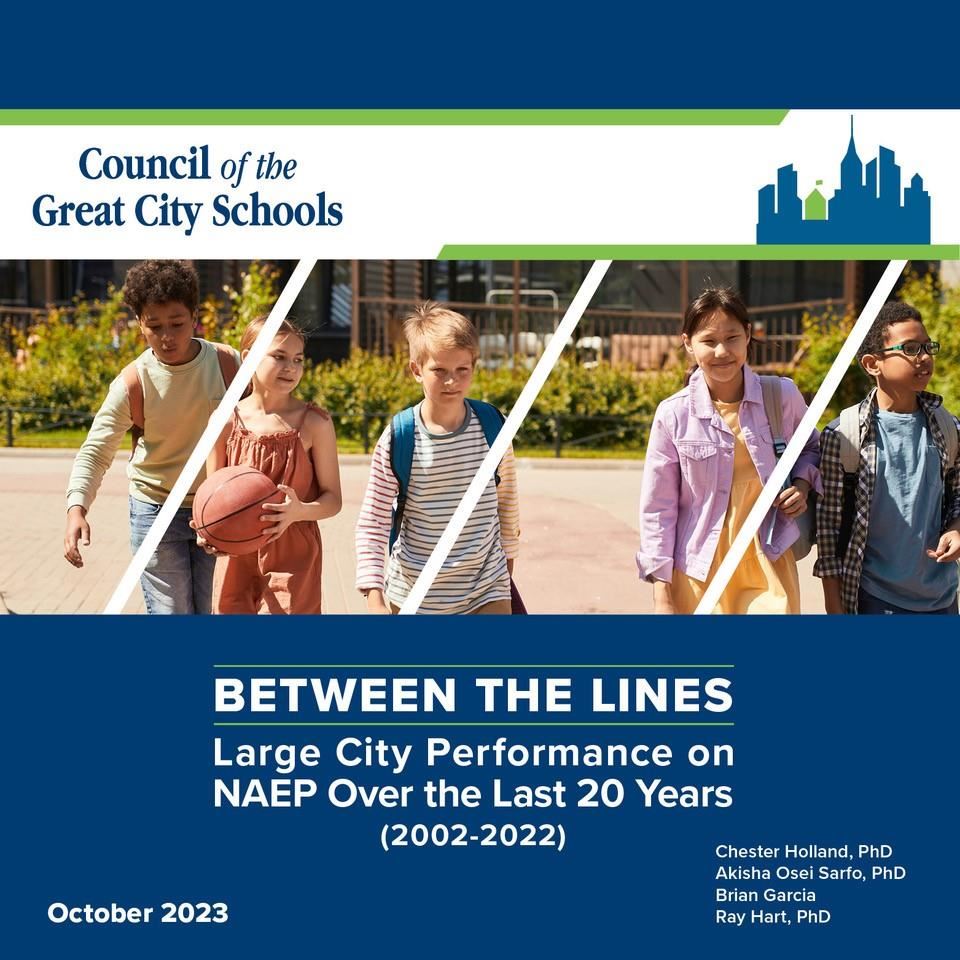- Council of the Great City Schools
- Between the Lines, Large City Performance on NAEP Over the Last 20 Years (2002-2022)
Featured Reports
Page Navigation
- Crisis Communication Guidebook
- Building Safer School and Communities
- Between the Lines, Large City Performance on NAEP Over the Last 20 Years (2002-2022)
- Supporting Excellence Framework
- Mirrors or Windows
- Investing ARP Funds Blueprint
- Interim Progress Assessment for Federal Relief Funds
- Leadership Transition Guide
- Pandemic-Era Changes in Urban School Leadership
- CGCS Strategic Support Team – Puerto Rico – Special Education
-
Between the Lines, Large City Performance on NAEP Over the Last 20 Years (2002-2022) looks at data from the National Assessment of Educational Progress (NAEP) to understand differences in student performance between large cities and students nationally over the last 20 years, including after the effect of the COVID-19 pandemic.
The report found that the gap between student performance in large cities and students nationally has been steadily shrinking and that urban schools have been demonstrating growth and progress over the last 20 years. In addition, Large City schools appear to have staved off the deep declines in test scores to such a degree that any progress that had been made in closing achievement gaps between cities and public schools across the country was preserved.
One area of concern from this analysis is outcomes on fourth grade mathematics assessments, which experienced a significant increase in the gap in performance between students in Large City schools and those of public-school students nationwide. These fourth-grade mathematics results should give educators and decisionmakers pause and inspire conversation to get Large City students back on track to close achievement gaps in this area. The report concluded that if policymakers continue to invest in urban school systems, the gap in performance between students in large cities and students nationally could continue on its historical course toward closure.
Key Findings From the Report:
Fourth Grade Reading
“The gap in fourth grade reading scores between students in large cities and students nationally has continued to shrink to less than half the size of the gap observed in 2002 (14.7 scale score point gap)—reaching a twenty-year low in 2022 (7.2 scale score point gap).”
“The achievement gap reduction in results on fourth grade reading tests between large cities and the nation over time—even with the pandemic’s impact on student learning—suggests that schools and districts in large major cities have been increasingly effective in improving opportunities for student learning.”
8th Grade Reading
“The gap in eighth grade reading scores between students in large cities and students at the national level has declined significantly, to about one-third of the gap in 2002 (from 12.5 scale score points in 2002 to 4.2 scale score points in 2022)—the smallest gap observed in the 20-year timeframe.”
“Comparisons of year-to-year changes in eighth grade reading average scale scores between the National Public and Large City jurisdictions show gains that have typically been greater, and losses that have typically been smaller in the Large City jurisdiction.”
“If the trend that shrank the eighth grade reading gap between students in large cities and students nationally by approximately nine percent with each NAEP administration since 2002 continues, and consistent growth is assumed, the gap would be eliminated within the next 10 years, by 2033”
8th Grade Math
“While the results of the 2022 administration of eighth grade mathematics NAEP tests show larger declines when compared to other grade-subject tests, the difference in those declines across jurisdictions is among the lowest in the time span examined—indicating that the gap between the National Public and Large City jurisdictions was not affected.”
Media Contact:
Contact Name
Contact@email.com
(000) 000-0000
Contact Name
Contact@email.com
(000) 000-0000
Contact Name
Contact@email.com
(000) 000-0000
Media Contact:
Contact Name
Contact@email.com
(000) 000-0000
Contact Name
Contact@email.com
(000) 000-0000
Contact Name
Contact@email.com
(000) 000-0000


